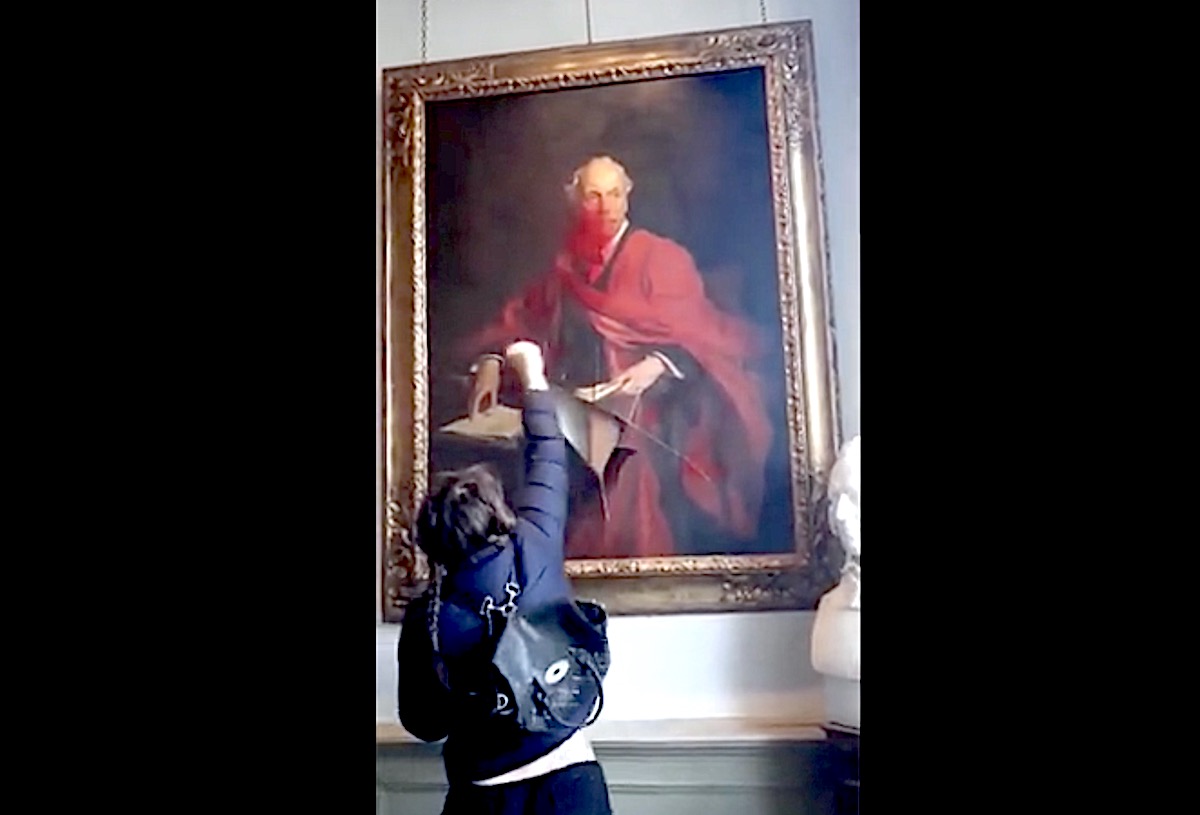Cambridge, UK—Police Authorities have launched an investigation following vandalism at Trinity College, Cambridge, that targeted a painting of Lord Balfour, the British politician associated with the creation of Israel. The incident prompted concerns and calls for the woman seen wearing a distinctive Mulberry™ backpack to be arrested.
The damage to the 1914 portrait by the artist Philip Alexius de László was reportedly caused by an activist affiliated with Palestine Action, a group advocating for Palestinian rights. The painting was defaced with slashes and sprayed with red paint, an act documented in footage circulated on social media platforms. (see below)
A spokesperson for Palestine Action confirmed their involvement, stating that their activist “ruined” the portrait as a symbolic gesture against Lord Balfour’s historical role in the Balfour Declaration. This declaration, issued in 1917 during Balfour’s tenure as foreign secretary, expressed Britain’s support for the establishment of a Jewish national home in Palestine, a decision contentious in the context of the ongoing Arab-Israeli conflict.
Cambridgeshire Police received an online report of the criminal damage and promptly dispatched officers to Trinity College to gather evidence and initiate an inquiry. At present, no arrests have been made in connection with the incident.
In response to the vandalism, Trinity College expressed regret over the portrait’s defacement, highlighting the institution’s commitment to preserving its cultural heritage. Support mechanisms have been put in place to assist affected college community members.
The act of defacement underscores the enduring controversy surrounding Lord Balfour’s legacy and the Balfour Declaration’s impact on the Middle East. While some view it as a catalyst for the establishment of Israel, it remains a subject of debate and critique, particularly regarding its implications for Palestinian sovereignty and self-determination.
As the investigation unfolds, questions persist about the boundaries of protest and the preservation of historical artefacts, igniting discussions about the complexities of memory, justice, and reconciliation in contentious political histories.

Arthur Balfour, born on July 25, 1848, was a prominent British statesman and a key figure in late 19th and early 20th-century politics. He hailed from an aristocratic family and received his education at Eton and Trinity College, Cambridge. Balfour entered politics in the 1874 general election, representing the Conservative Party.
Balfour served in various governmental roles, including Chief Secretary for Ireland and Secretary of State for Scotland, before assuming the position of Prime Minister in 1902. His tenure as Prime Minister was marked by efforts to reform the British education system and address issues related to social welfare.
However, one of the most notable aspects of Balfour’s political career was his involvement in foreign affairs. As Foreign Secretary from 1916 to 1919, he was pivotal in drafting the Balfour Declaration, issued on November 2, 1917. This declaration expressed the British government’s support for the establishment of a “national home for the Jewish people” in Palestine, then under Ottoman rule.
The Balfour Declaration was a significant development in the Zionist movement, as it represented one of the first expressions of international support for establishing a Jewish homeland. While many Jewish communities enthusiastically supported the declaration, it also sparked controversy and tensions with the Arab population in Palestine.
After his term as Foreign Secretary, Balfour became active in politics and diplomacy. He served as Lord President of the Council and later as the first Chairman of the Society for Psychical Research, reflecting his interest in spiritualism and the paranormal.
Arthur Balfour’s legacy extends beyond his political career; he was a noted philosopher and writer, contributing to philosophical discourse with works such as “A Defense of Philosophic Doubt” and “Theism and Humanism.” His impact on British politics and international relations, mainly through the Balfour Declaration, remains significant today.
Philip Alexius de László, born as Fülöp Elek László, was a renowned portrait painter known for his elegant and lifelike depictions of European royalty, aristocracy, and notable figures of the early 20th century.
Born on April 30, 1869, in Budapest, Hungary, de László pursued law studies before turning to art. He received formal training at the Hungarian Academy of Fine Arts in Budapest and later studied under Bertalan Székely and Károly Lotz.
De László’s talent as a portraitist quickly gained recognition, leading to commissions from prominent figures across Europe. His ability to capture the character and essence of his subjects and his mastery of technique and composition elevated him to prominence in the art world.
In 1900, de László settled in London, establishing a successful portrait studio and becoming a sought-after artist in British high society. His clientele included members of the royal family, politicians, industrialists, and celebrities, earning him a reputation as one of the leading portrait painters of his time.
Known for his skilful use of light and colour, de László’s portraits exuded grace, sophistication, and psychological depth. His subjects appeared as individuals and symbols of their respective eras, capturing the spirit of the early 20th century.
De László’s career flourished throughout Europe and the United States, where he received numerous accolades and honours for his contributions to the arts. He was elected a member of the Royal Society of Portrait Painters and the Royal Academy of Arts, further solidifying his status as a preeminent portraitist.
Despite the outbreak of World War I and the subsequent upheavals in Europe, de László continued to paint prolifically, leaving behind a vast body of work that remains highly regarded today. His portraits, characterized by their exquisite detail and vibrant depth, are enduring testaments to the individuals and the times they represent.
Philip Alexius de László passed away on November 22, 1937, leaving behind a rich artistic legacy that continues to inspire and captivate audiences worldwide. His contributions to portrait painting have earned him a lasting place among the masters of the medium, ensuring that his work remains celebrated and admired for generations to come.

